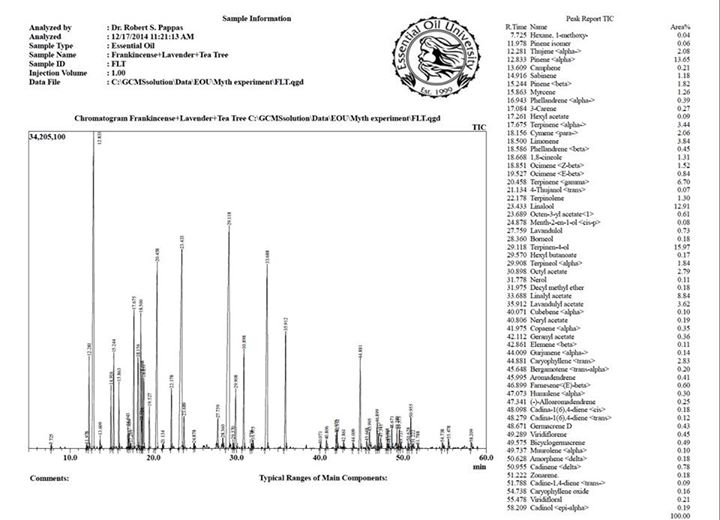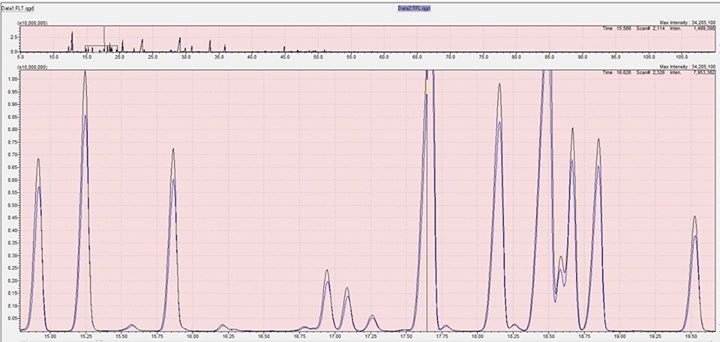Myth
#13:
The order in which you blend the oils in an aromatherapy blend
changes the chemistry and the odor of the blend and makes a
difference therapeutically.
For the chemistry of a blend to be different depending on the
order of the mixed ingredients there would have to be chemical
reactions taking place at each stage of the blending to cause such
differences. But since most essential oils contain components that
are common to many different oils, gladly this is not typically a
possibility under normal conditions. Think about it, if these
reactions occurred upon mixing different oils then one would also
expect to see the molecules within a single oil reacting with each
other, under normal conditions, in very short periods of time as
well. Wouldn't that be a tragedy!
The truth is that as long as you are mixing each oil in the EXACT
same percentage in each trial, the order of blending each component
would almost never reveal a significant effect. When people do claim
to notice differences in blends based on order of component addition,
its typically because they do not have the ability to conduct the
experiment with quantitative accuracy. For example, it would not be a
scientific experiment to do various blends using drops of essential
oil from orifice reducer bottles or even by counting drops from a
pipette. The reason being that drops are often drastically
inconsistent, even when using the same oil with the same dropper. The
only way to accurately put together the blends is to use a digital
scale, I recommend one that can weigh out to at least 0.001 gram. If
all the components are added to blend in the exactly the same amount
each time the blend is made and the components mixed thoroughly then
the odor and chemistry should be identical each time, regardless of
order they were added to the blend.
This is not to say that its impossible for blending order not to
play a role in differences in the blend if the blend is done under
unusual circumstances. For example, if you add ingredients A and B
together and let it set for days then add in ingredient C you could
very well perceive some odor differences compared to doing the same
blend in reverse order because you have given the blend some time in
between adding ingredients for very minor chemical reactions to
occur, maybe some oxidation etc. could also be a factor. But even
under this scenario, the chemical makeup on the GC will be almost
identical even though very minor reactions could have occurred to
affect minor aspects of the odor. In most cases, when people are just
blending at home, a few oils in a matter of a few minutes, the order
of blending will not matter at all, assuming you have the ability to
be consistent in each ingredient during each trial. But since most
people don't have digital scales, they will most likely see
differences in the same blend from trial to trial, even if they
ALWAYS blend the oils in the exact same order. This is just due to
the inaccuracies of formulating with drops.
Just to prove the point experimentally, I did a quick experiment
and documented it by video. In the experiment we blended 3 oils
(Frankincense, Lavender and Tea Tree) in different order, but using
the same amounts by weight each time and then analyzing each blend by
GC/MS and showing that the blend is chemically identical in each
trial. The results below are from two different trials (out of the 6
total possibilities) where you can clearly see that the chemical
composition of each blend is the same (within the error of the
instrument, I could literally run the exact same sample twice on the
same instrument and get the same small differences in the percentages
as shown for these two trials). The final picture shows a blown up
region of the chromatographs superimposed on one another showing that
all the peaks line up exactly in each trial. The odor of each blend
was also identical.
For some fun we did the following short youtube video summarizing
the experiment. The next time someone tries to tell you that the
order of blending matters just send them this video link. Enjoy!
https://www.youtube.com/watch?v=18cU7G63je4


Dr. Robert Pappas is a chemist with
more than two decades of experience in the essential oil industry. He
has worked extensively with professionals from around the world, and
focuses primarily on essential oil analysis and education, performing
quality and purity testing for clients large and small. His opinions
are widely respected in the essential oil industry. For a time, Dr.
Pappas' relationships with growers prompted him to begin sales of
essential oils to better serve the needs of his customers as they
sought the best options for essential oil purchases. It was during
this period of time that Welcome to Life! began. Although Dr. Pappas
later sold the burgeoning business to his brother, we continue to
provide our oils exclusively from from this source. We feel confident
that the oils remain as pure and amazing as they were under Dr.
Pappas, and are pleased to offer them to our clients.
Dr. Pappas continues to study, analyze,
and educate about essential oils. With his permission, we reprint his
Essential Oil Myths so you can know the truth among the lies in the
essential oil industry. For further study and verification, please
visit Dr. Pappas' Facebook page:
https://www.facebook.com/search/top/?q=essential%20oil%20university
 Loading... Please wait...
Loading... Please wait...
